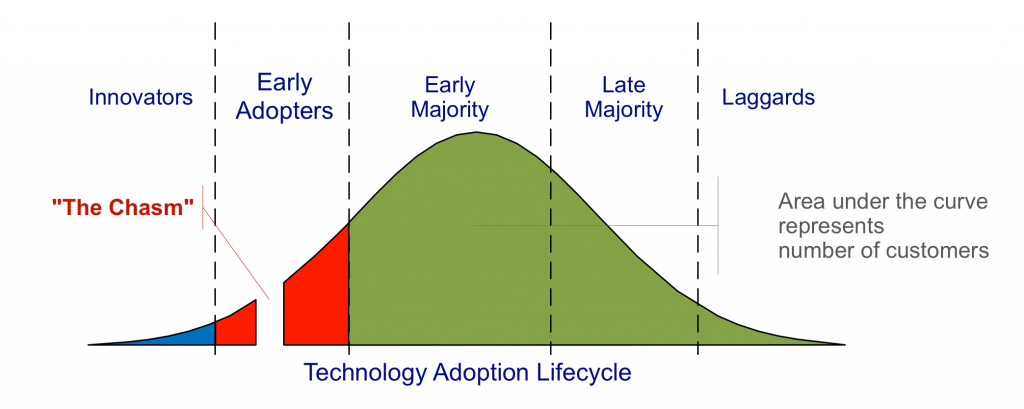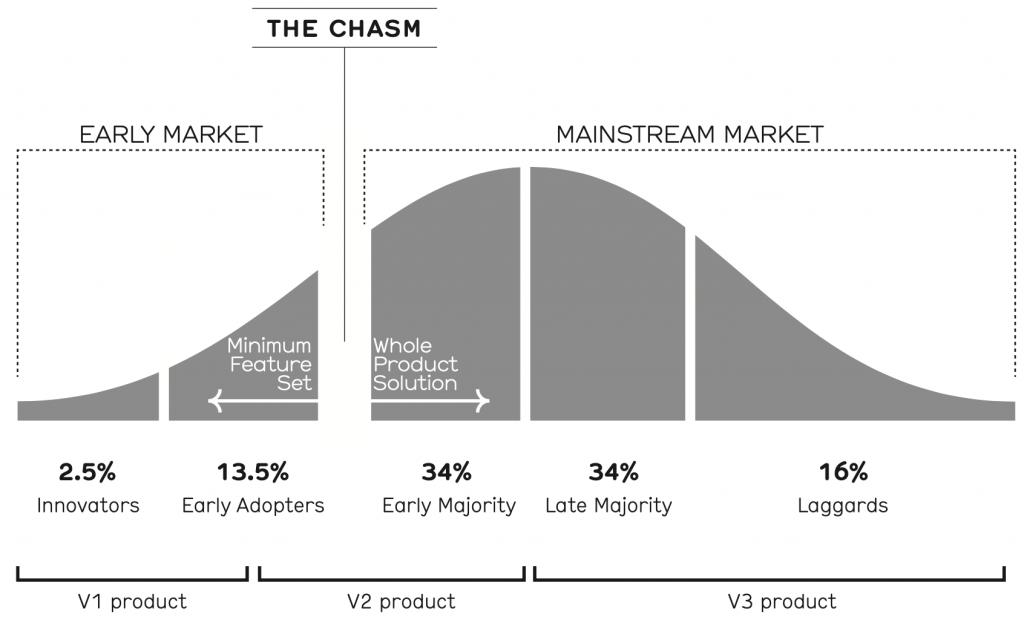
I enjoyed reading the book Build: An Unorthodox Guide to Making Things Worth Making and I started suggesting it to some of our clients. The most interesting takeaway is the development roadmap that the author suggests is typical for successful hardware products.
The author, Tony Fadell, has a wealth of experience developing and launching new products, including nearly 10 years at Apple as a VP in charge of the iPod and then of the iPhone. He founded Nest and launched a smart thermostat that has been a big success.
The technology adoption lifecycle
To understand Fadell’s logic, one first needs to remember this graph from the classic Crossing the Chasm book.
When a new product appears, it is usually not fully baked. It is not ready for 100% of the market. It usually sells easily to innovators, but that’s a small proportion of the whole market. Selling to some early innovators is possible, but there is a “chasm” that makes it hard to sell to all early adopters, and especially to very mainstream customers.
Versions 1, 2, and 3 of a new product
The author observed that a new hardware product needs to go through several versions, each one better than the previous one, to be in a position to capture most of the market:
- Version 1: the first model that a new company puts on the market. It is far from perfect but, if it is innovative and provides some value to users (or simply because it is different and ‘cool’), the innovators and some early adopters will be tempted to buy it.
- Version 2: the second model, without the main issues of version 1, so that some people in the early majority start to buy it. That’s not easy for a variety of reasons, and it is called “crossing the chasm”. The company needs to provide decent reliability and customer support. The whole buying & using experience needs to be relatively smooth.
- Version 3: the third model, which goes after more of the market, including some late majority customers and maybe even some of the laggards. They don’t want any bad surprises or hassle.
Here is a nice illustration from Fadell’s book Build:
The objectives of each version are different:
- Planning before v1: spend some time (maybe a few weeks or months) researching the space, planning for the way to approach the opportunity, identifying risks and studying them, and talking to potential investors.
- Developing and launching v1: confirming there is market demand, getting feedback from the market, and confirming a good business can be built. The product is still a bit of a ‘prototype made in the thousands’, and it may be buggy in some areas. Many funded startups do not try to be profitable at this stage, but bootstrapped companies have to be pretty smart and ensure they cover their costs.
- Developing and launching v2: fix the product’s main shortcomings in the eyes of the target customers, and grow sales. Push v2 to the market fast, as you are probably embarrassed about some aspects of v1 and some customers’ complaints about it. If things go well, start making some money.
- Developing and launching v3: fine-tune the whole customer journey and the business (work on distribution, partnerships, and marketing, and start making serious money if it works well).
*****
How about you, if you have been launching new products with incremental improvements from one version to the next, is this something that you have observed?


